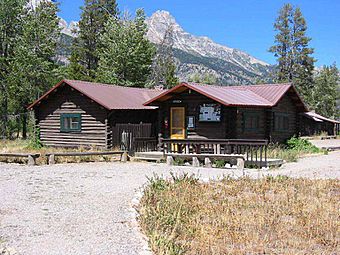Double Diamond Dude Ranch Dining Hall facts for kids
Quick facts for kids |
|
|
Double Diamond Dude Ranch Dining Hall
|
|
 |
|
| Location | Grand Teton National Park, Jackson Hole, Teton County, Wyoming, USA |
|---|---|
| Nearest city | Moose, Wyoming |
| MPS | Grand Teton National Park MPS |
| NRHP reference No. | 98001028 |
| Added to NRHP | August 18, 1998 |
The Double Diamond Dude Ranch Dining Hall is a historic building located in Grand Teton National Park. It was built in 1945 and was the main building of a "dude ranch." A dude ranch is a special type of guest ranch where visitors can experience a Western lifestyle. This ranch was started by Frank Williams and Joseph S. Clark, Jr..
The Double Diamond Ranch first opened in 1924. It had tent cabins and log buildings for a kitchen, dining hall, and lounge. In 1943, more log cabins were added for tourists. The larger dining hall was built two years later in 1945. Sadly, a big fire in 1985, called the Taggart Lake Fire, destroyed most of the ranch. Only the dining hall and five cabins survived.
The dining hall is now listed on the National Register of Historic Places. This means it is an important historical site. It is a great example of "rustic architecture," which uses natural materials like logs and stone. Since 1970, the Double Diamond property has been a hostel for mountain climbers. It is now known as the Climbers' Ranch.
Contents
History of the Double Diamond Ranch
Frank Williams, who was a guide and former wrangler at another ranch, teamed up with Joseph S. Clark, Jr. Clark came from a wealthy family in Philadelphia. He provided the money to open the Double Diamond Ranch in 1924. The ranch was built on land claimed by Frank Williams' wife, Emma.
Joseph S. Clark, Jr. later became the mayor of Philadelphia. He also served as a U.S. senator from 1957 to 1969. The ranch grew from about 14 acres to 54 acres in 1926. This happened when they bought part of the nearby Manges property.
Early Days: A Ranch for Boys
In its early years, the Double Diamond Ranch mostly welcomed boys from wealthy families in the eastern United States. Guests stayed in tents. There was a small dining hall, a lounge, and a general store. The ranch attracted visitors mainly from the Philadelphia area.
A season at the ranch, from June to September, cost $800. This price included travel from Philadelphia. New guests needed references to be accepted. The ranch could host about 25 guests at first. By the 1930s, it could host up to 35 guests.
Changes and New Ownership
As Joseph S. Clark, Jr. started his career in law and politics, he became less involved with the ranch. In 1946, he sold his share to Harry and Nola Williams Brown. However, he bought back a small piece of land for his own summer cabin.
In 1943, the ranch started adding cabins. This change meant they could welcome more families. The main dining hall, which is still standing today, was built in 1945. Harry Brown and Nola Williams Brown took half ownership in 1948. The Williams family kept running the ranch until Frank's death in 1964.
After Frank's death, the National Park Service bought the ranch for $315,000. They allowed the ranch to continue operating until 1969. The dining hall is one of the few parts of the original ranch that survived the big fire.
What the Dining Hall Looks Like
The dining hall, built in 1945, is a one-story building shaped like a "U." It is made of logs. On its north side, there is a large fireplace and chimney made of stone. The room that used to be the main dining area is now a library and lounge. The old commercial kitchen is now a shared kitchen and dining space for guests.
The outside of the building is stained a uniform brown color. The spaces between the logs are covered with thin strips of wood. This is a common building style in the area.
The Climbers' Ranch Today
The Double Diamond property, including the dining hall, has been leased to the American Alpine Club since 1970. The American Alpine Club helps mountain climbers. They renamed the facility the "Climbers' Ranch." It works like a hostel, offering affordable lodging for climbers.
The surviving cabins are used as dormitory-style rooms for climbers. The dining hall is a shared space where climbers can relax, eat, and plan their adventures.
The Double Diamond dining hall was officially added to the National Register of Historic Places on August 18, 1998.



